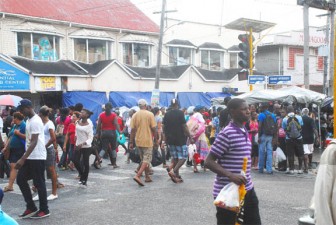Sustained inclement weather in the days immediately preceding Christmas did little to curb the enthusiasm for spending usually associated with this time of the year. In fact, in downtown Georgetown, Christmas spenders appeared to take the weather in their stride and if there were losers to the sustained showers they were, in the main, the street vendors, whose vantage points were, in some cases, ‘washed out’ by the downpours.
As far as Stabroek Business could tell consumer spending the city in the final week leading to Christmas focused on household items. Our visits to the city’s major furniture and household appliance outlets as late as Christmas Eve day revealed that consumer interest was mainly on items of furniture, household appliances and kitchen utensils. Discreet enquiries also revealed that the various ‘no deposit’ and ‘low deposit’ deals coupled with gifts linked to purchases on offer at the various furniture and household appliance stores were more than sufficient to push hire purchase credit levels up, “above last year’s levels”, according to a Singers employee.

Elsewhere, low budget Christmas spenders were seeking bargains in downtown retail enterprises. The throngs of shoppers that filled Regent, Robb and Water streets appeared to have curtains, decorations, toys and selected household appliances high on their shopping lists and the various Chinese trading outlets certainly appeared to be rivalling the traditional downtown retail stores for patronage.
This year a new generation of high-rise shopping blocks joined the City Mall and the crowds in those edifices creating an accentuated –even if misleading, in some cases – sense of consumer spending. If both of the ‘twin towers’ erected on the corners of Regent and Camp streets directly opposite each other attracted considerable numbers, patrons appeared outnumbered by younger people “hanging out” and as one group outside the City Mall put it, “spreading joy”.
Oddly enough, there was only limited evidence of the huge crowds that usually pack the supermarkets on Christmas Eve day. Not that food, this Christmas, was any less important than in previous years. Christmas Day was to tell its own story as Stabroek Business discovered that some supermarkets opted for trading on both Christmas Day and Boxing Day.
On both days large crowds made heavy purchases. It appears that this year food purchases were made to queue up behind household items and gifts.
More than a week before Christmas Day the city streets were choked with traffic. Far too many people insist on driving their cars into the heart of Georgetown during the Christmas period. It is, to say the least, an unwise option even if, arguably, there is something to be said for finding a way around seriously inflated taxi fares.
When you add bad weather to the customary seasonal demand for hired transportation, the shopping days preceding Christmas brought taxi operators a considerable windfall.
On Monday (Christmas Eve), shoppers, arms filled with bags and with one eye on the weather, paid up to four times the customary fare to get home.
At Christmas spending power ought not to be measured purely on the basis of presumed disposable income. Guyanese cheerfully go the extra mile at Christmas. Some shoppers with whom Stabroek Business spoke told us that this year, their spending was a function of the generosity of relatives residing overseas.
The Laynes, a mother and three excitable children had travelled from West Coast Berbice to the city on Thursday to shop for carpets, curtains and toys. Wanda Layne told us that her husband had arrived from the interior just a few days earlier and that his earnings would be enough to guarantee the family “a good Christmas.” The mining industry’s 400,000-ounce gold yield in 2012 would have made a difference to a number of Guyanese homes.
Both the Private Sector Commission (PSC) and the Georgetown Chamber of Commerce and Industry and Commerce (GCCI) had predicted aggressive seasonal consumer spending this year, their predictions seemingly based on their understanding of spending patterns rather than on any reliable data. In the final analysis and based on our own assessment of urban consumer behaviour in the period leading to Christmas their predictions appeared to have been realised.





